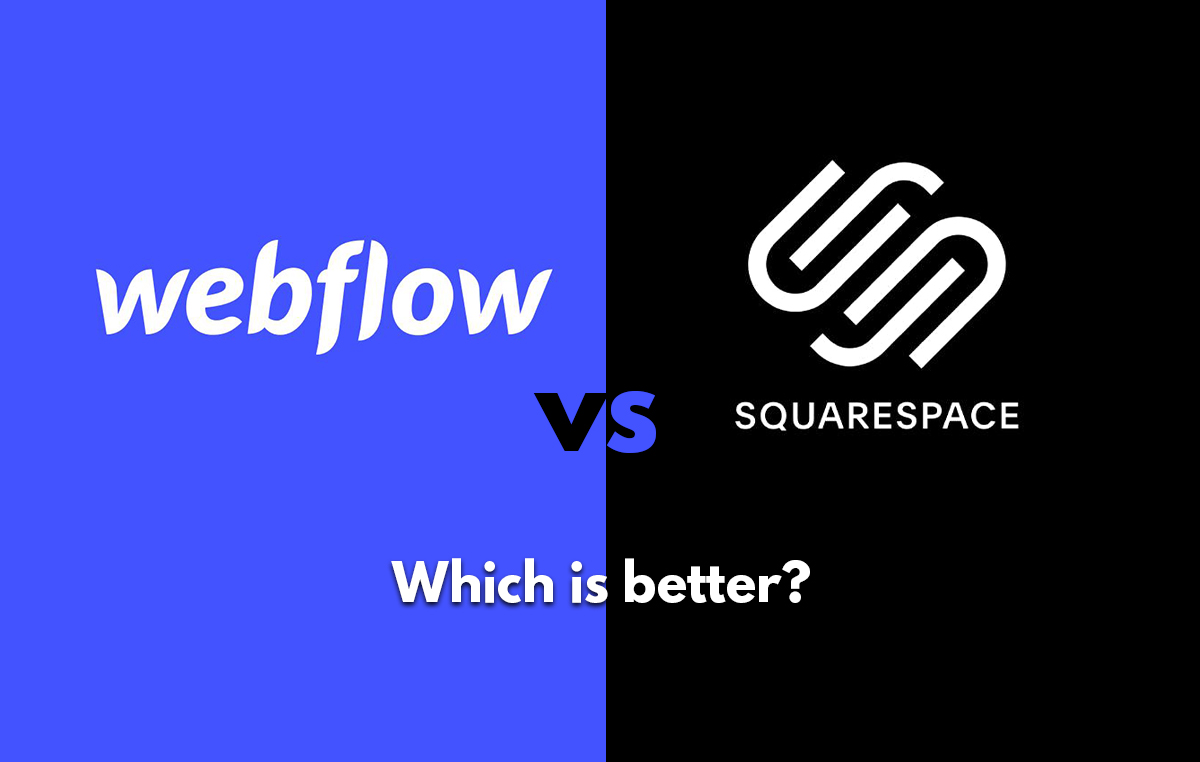Webflow vs Squarespace.. This is a tricky one.
Both are great website builders, and each has its pros and cons, but which one is right for you?
We know it can be tough to make a decision, so we’ve created this handy guide to help you choose the platform that’s perfect for your needs.
Before anything else, we recommend that you try both platforms first with their free trials:
Click Here to Claim Your FREE Webflow Trial
Click Here to Claim Your FREE Squarespace Trial
Keep reading to know which website builder is for you…
Importance of Choosing the Right Web Builder
There are many web builders to choose from when it comes to creating a website. And selecting the right platform is essential. If you choose the wrong platform, you could end up wasting time and money on a website that’s difficult to use and doesn’t look the way you want it to or worse, it doesn’t meet your needs at all.
That’s why it’s important to do your research in order to determine the best platform that’s right for you or your brand. Webflow and Squarespace are both great website builders, but they each have their own strengths and weaknesses.
To better understand how to choose your ideal website builder, we’ve listed down some general benefits of using one, which can help you granularly identify what you need. We’ve also combined the other relevant information on Webflow’s and Squarespace’s features that we’ve broken down in the later sections of this article.
Website Builders Are Usually Easier to Use
Of course, this depends on the website builder as there are a plethora of them that are unique and alike such as the case with Webflow vs Squarespace.
But one of the main benefits of using a website builder is that they are easier to use compared to manually coding a site. Both Squarespace and Webflow are considered drag-and-drop website builders, which means you can create any kind of website without any coding experience.
This makes them perfect if you want to create a personal website, a business website or a portfolio website which you can do without having to learn how to code.
Website Builders Can Be Affordable
Another advantage of using a website builder is that they are generally affordable. In fact, there are many website builders that have free plans or that their paid plans are very reasonable.
As a result, website builders are a great option for small businesses or anyone on a budget who still wants to craft a great looking website.
Most Website Builders Are Versatile
Website builders can be used to create all kinds of websites, from a simple personal blog and portfolio to custom websites and complex ecommerce stores. Both Squarespace and Webflow offer a range of features and templates, so you can create the perfect website that meets your needs.
Now that you know some of the benefits of using a website builder, let’s take a closer look at the pros and cons as well as a brief overview of each platform, before moving to a more in-depth breakdown of their different aspects.
An Overview of Webflow and Squarespace
Webflow

Click Here to Claim Your FREE Webflow Trial
Webflow is a cloud-based website builder that enables you to create responsive websites without any coding knowledge. With its drag and drop interface along with its in-depth customisation features, you can create professional-looking websites.
Webflow also offers a range of paid and free templates that can help you create your ideal website. And, if you do have some background in coding, Webflow also enables you to add custom code to your site.
Pros
One of the main advantages of using Webflow is that anyone can make specific changes or customisations with any chosen template which we will be discussing later on.
Another advantage of using Webflow is that it offers a range of integrations that you might find very useful in the long run. This makes it versatile and suitable for all kinds of websites.
Cons
One of the main disadvantages of using Webflow is that it can be challenging to use especially if you’re a beginner. If you want to create your own website with lots of features and functionality, you may need to hire a developer or a few web designers who has experience with the platform or take some time to watch their video tutorials on adding the features you want to your site.
Squarespace

Click Here to Claim Your FREE Squarespace Trial
Squarespace is another cloud-based website builder that helps you create responsive websites without the hassle of coding. It has an easy to use drag and drop editor and offers a range of features and templates.
Squarespace also offers e-commerce plans, so you can create an online store, a blog as well as a traditional website.
Pros
Some of the main advantages of using Squarespace is that it’s very easy to use and that Squarespace’s templates are all free. This makes it both suitable for all kinds of websites, including e-commerce stores.
Another advantage of using Squarespace is that it’s affordable.
Cons
A few of the main disadvantages of using Squarespace is that it is less customisable for individuals who want to implement more creative inputs in certain aspects of their site.
As you can see, both platforms have their own pros and cons. We understand that you will need to decide which one is right for you not only based on your needs and budget but also on more thorough information.
Below we’ll be discussing the comparison between Webflow and Squarespace in key areas of building a website that is important for you to know before getting started on testing either of them.
Templates, Design and Customisation

Squarespace offers more than a hundred templates to choose from which are all free. Whereas Webflow offers roughly over 40+ templates to use without charge, out of the 400 templates they have. The rest can be purchased if you want to use them.
When it comes to the customisation of the templates provided by both, Webflow offers more technical customisation than Squarespace.
But what do we mean by this?
You can embed HTML, JavaScript and CSS to your Webflow site, giving you more control. Additionally, they offer what others would consider advanced features which is the CMS collection (which we will discuss later on) as well as provide you with the freedom to customise almost all of your site’s elements specifically.
Take a look at this video by Webflow to understand what we mean by customising specific elements to your preferences when it comes to web design, as well as the opportunity to maximise the CMS collection feature.
With Squarespace, there’s less customisation that can be done and you’ll be more dependent on the templates offered when it comes to adding your own web design to the template. In other words, how you design your website with your chosen elements will depend on the template and behave more or less according to the template you’ve chosen.
However, their templates are still quite flexible to customise them to your brand’s aesthetic or to your preferences, and you can use them to create a wide variety of websites. So basic areas such as fonts, colour preferences and so on can be changed with ease.
Ease of Use

Squarespace is better maximised by beginners or individuals who do not have the technical knowledge or time to understand how Webflow works. If you want an easy to use website builder that can save you time, Squarespace allows you to easily create a website in a lesser amount of time compared to Webflow.
Domains

Domain names are an important part of any website. They help people find and remember your site, and can also help with SEO. If you are a beginner, it’s important to note that when it comes to choosing a domain name, there are a few things to keep in mind before actually moving on to creating your website with Webflow or Squarespace which we’ll be breaking down in this section to help you save time.
First, think about what you want your domain name to say about your website or business. You want it to be descriptive and easy to remember, but you also want it to be unique. One way to come up with a good domain name is to brainstorm a list of keywords related to your website, and then play around with them until you find something that sounds good.
Once you have a few potential names in mind, it’s time to check their availability. You can do this by typing them into a domain name checker like GoDaddy or NameCheap. If the name you want is already taken, you’ll have to come up with something else.
Once you’ve found an available domain name that you’re happy with, the next step is to register it. This is usually done through a domain name registrar like GoDaddy or Namecheap. You’ll have to pay a yearly fee to keep your domain registered, but it’s worth it to have a unique and memorable website address.
Now, if you’re not sure which registrar to use, Squarespace and Webflow have different setups which might help you decide.
Custom domains for Webflow require a third party for you to purchase your domain from as they do not offer free registration for a custom domain in any of their plans. The platforms we recommend where you can purchase your domain are Google Domains or GoDaddy. Once you’ve registered your domain, you can connect it to your Webflow site and start building your ideal website. With Squarespace, you can have a free custom domain for the first year, where this is actually available in all of their plans, which you can register and purchase through Squarespace itself.
Features and Flexibility
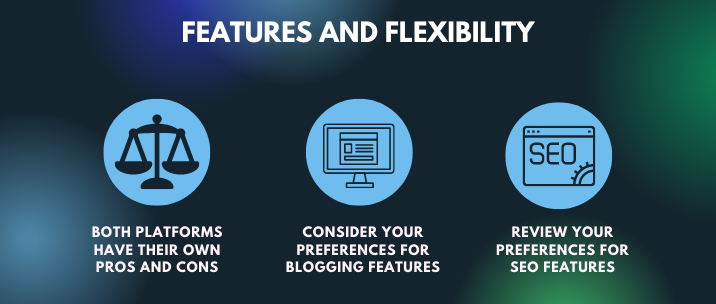
When it comes to features and flexibility, Webflow and Squarespace are both great options. However, it’s important to note that they each have their own advantages and disadvantages.
As established earlier, Webflow is a great option for people who want total control when it comes to web design. Meanwhile, Squarespace is a great option for people who want a beautiful website without having to learn about the basics of CSS or HTML or any additional procedure when adding certain features to their website (for example, learning what a CMS collection is).
In this section of the article, we’ll dive deeper into the SEO and blogging features that Squarespace and Webflow offer.
Blogging

Squarespace offers all of the standard blogging features that you would expect, such as comments, social media sharing and RSS feeds, and a range of other fantastic extras. Plus, its built-in SEO features are incredibly powerful – something that’s crucial for any blogger. But more on this later on.
On the other hand, Webflow’s blogging features offer a quick solution for creating blogs with its automatic creation of Dummy content within an individual’s CMS Collection. Take look for yourself!
In essence, creating and publishing blogs can be a breeze with Webflow once you’ve understood it. More so, its ten thousand item limit may be enough for some bloggers or businesses out there.
Overall, both platforms offer excellent features – it just depends on what you’re looking for when creating a blog post. If you want a wide range of features and tools that are easier to use and learn, Squarespace is the clear winner. But over time, if you plan to further develop your site wherein you’ll need more flexibility and control over your blog’s design, Webflow is the best option.
Search Engine Optimisation (SEO)

SEO is one of the most important things to consider in any website. Without good SEO, your website will struggle to rank in search engines, and you’ll miss out on potential traffic and/or customers (this is especially crucial for small online stores and mid sized ecommerce businesses).
Luckily, both Webflow and Squarespace have a range of built-in SEO editing features such as being able to add descriptions and page titles as well as the ability to generate sitemaps that will help you optimise your website for search engines.
It is for certain that both platforms are great options if you’re worried about your site’s SEO. You can also control how your site looks on different devices, making sure that it’s as mobile-friendly as possible. So, no matter which platform you choose, you can be sure that your website is optimised for search engines.
Despite their positives, Squarespace and Webflow do have some slight differences that are advantageous.
There are a few reasons why you might want to hide a certain webpage or your overall website from search engines. Maybe you’re still working on it and don’t want people to see it until it’s finished, or maybe you don’t want some pages to be indexed. Whatever the reason, if you’re using Squarespace, you can do just that.
You may have guessed by now that Webflow is a great option for people who want complete control over their website’s SEO. With Webflow, you can customise every aspect of your site’s metadata, including titles, descriptions and keywords. This level of control can be extremely helpful in boosting your website’s ranking on search engines.
Tech Support
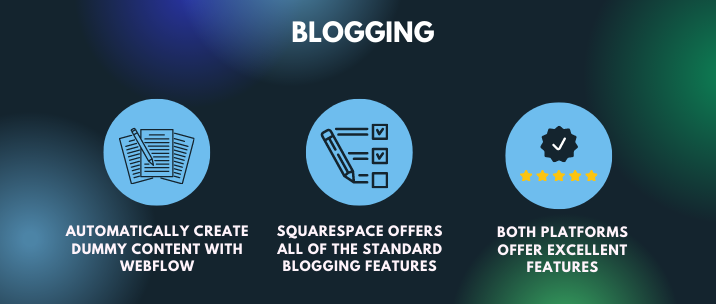
Both Squarespace and Webflow have forums where you can ask questions and get help with your website. We find that these forums are significantly important and helpful because they allow you to get information and tips from other users with the same issue as yours. More so, they also allow you to help other people by answering their questions should you already know the answer to the same problem you encountered beforehand. So in a way, there’s this sense of community surrounding a particular problem that you don’t necessarily have to face alone.
If you’re using Webflow, you can go to the forum section by simply scrolling down from your Dashboard and clicking Forum under the Learn & Get Help section. If you’re using Squarespace, from the homepage, you can go to the Resources section above and click Forum.
Additionally, Webflow has Webflow University which offers various crash courses on particular features that you can add to your site. Click here to check it out. On the other hand, Squarespace offers 24/7 email support and live chat should you need help with some issues or if you get stuck with something and need support right away. Although email is also available with Webflow, you can’t exactly contact Webflow directly since live chat is not a help channel they currently have.
Ecommerce or Online Selling
Limitations

Before moving on any further, it’s important to take note of the key limitations of Webflow and Squarespace in the context of ecommerce or online selling.
Both Webflow and Squarespace are good options when you want to start an online store. At this point, you can already have a good estimate or gauge as to how both website builders can be beneficial. But as mentioned, there are limitations to consider with their ecommerce plans and one such limitation with Webflow is the ability to sell only up to 3000 items. Therefore if your business sells a few types of items or specific items that don’t have many variations then Webflow is worth a try.
When using Squarespace, you don’t need to worry about the number of products that you can sell on your website, regardless of the plan you choose as you can sell an unlimited number of items. So if you’re planning to sell products online that are in bulk or in huge quantities with various varieties, Squarespace might be the better option for your business.
Focusing on the payment aspect, Webflow’s gateways are Stripe and PayPal, whereas Squarespace’s gateways include Stripe, PayPal and Square. Beyond these limitations, you’ll need to consider what each platform can offer that will be useful in your business. For example, Squarespace has a built-in sales analytics section whereas Webflow doesn’t, but you can integrate Google Analytics. We highly suggest that you read their respective pricing plans in order to determine which platform and plan you can work with.
We’ll now move on to discussing the marketing integrations that both website builders provide in the following section.
Integrations and Extensions
A Quick Breakdown
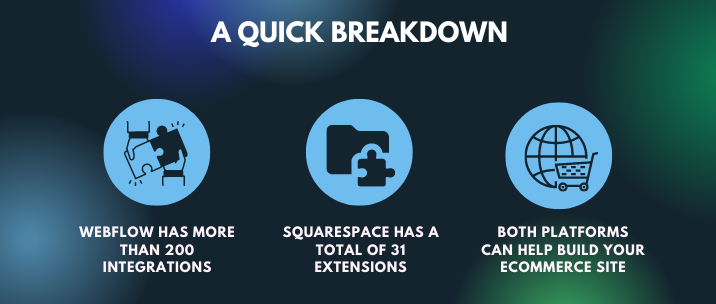
Webflow offers a broad range of integrations (more than 200 to be exact) which include Shopify, Zapier, Mightyforms, Google Analytics, Mailchimp and more. Take note though, that these integrations are actually instructions for adding your chosen integrations rather than actual integrations that are ready to be added to your site.
Squarespace offers an easier alternative, cutting back on the installation process despite that it does not offer as much as Webflow does. This platform makes it an optimal choice for getting your ecommerce site up and running if you’re in a hurry. Squarespace has a total of 31 extensions in the following categories:
- Shipping and fulfilment
- Finance
- Inventory
- Sales and marketing
TaxJar, Shippo, QuickBooks Commerce and MailChimp are just some of the few extensions listed on their site. To view the full list of Squarespace’s extensions and Webflow’s integrations you may click here and here.
Overall, both Webflow and Squarespace can help you build your ecommerce site. They have a lot of options and ecommerce features, and they both make it easy to sell products online. You’ll just need to subscribe to or purchase their ecommerce plans.
Social Media Integrations

One of the benefits of using Squarespace and Webflow to create your website is that you can connect your social media accounts to them. Connecting your social media accounts to your website is important because it makes it easy for people to follow your social media profiles.
There are a few creative ways to showcase your social media accounts. One way is to add social media icons to your website, allowing people to click on the icon and be taken directly to your social media page. Another way is to add a social media feed to your website, where people are able to see a stream or accumulation of your latest social media posts.
To add live social media feeds on Webflow, you can use Elfsight or Flockler which you can read more about here and here. For social media icons, let’s say you want to add a Twitter share button, you’ll be dabbling with dynamic embeds and a collection page or list as mentioned in their article here.
On the other hand, when you’re using Squarespace, you can add your live social media feed to your website via Embed Social where you simply have to embed a code onto your site which you can learn here. You can also use Elfsight as well.
To add social media icons, you’ll need to access the Social Links section in the Settings panel and add your social media or email URLs. What’s great about Squarespace is that it will be able to determine the platform of your URL. We strongly recommend you learn more about it via this link.
Pricing
When it comes to pricing, both Webflow and Squarespace offer different plans. But of course, some individuals prefer to test out the core or basic features that each platform offers, to get a good grasp of how the features will be able to serve as solutions to their needs prior to making a sound purchase.
Fortunately, both Webflow and Squarespace offer free options to build a professional website. Though Squarespace only offers a 14-day free trial. Below you’ll see an incomplete overview of Squarespace’s plans. To view the full pricing plans, click here.
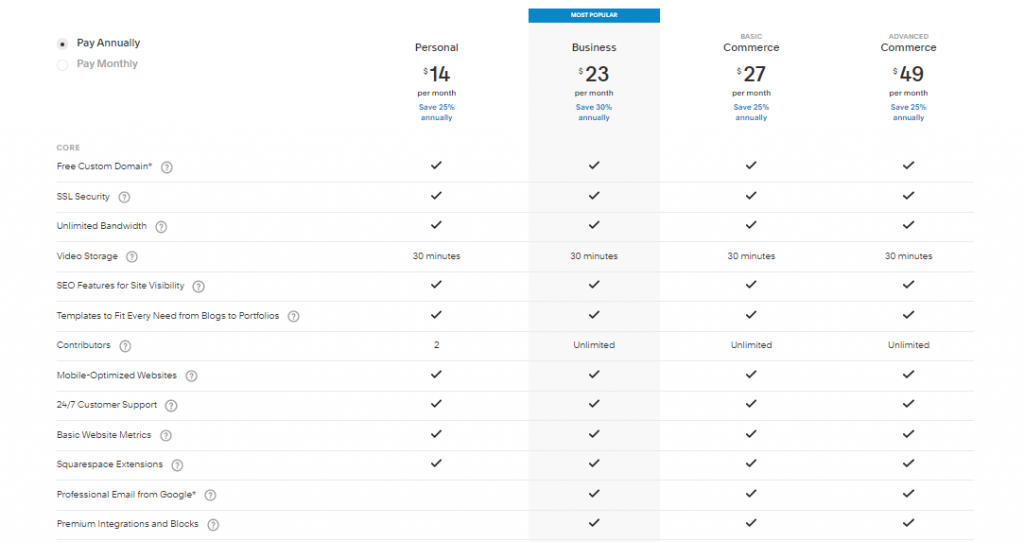
Meanwhile, Webflow allows individuals to utilise the platform for free without a limited time period. You read that right! So Get Started today, it’s free (seriously).
If you want to view the full price list click here, but it can get confusing once you’re looking at the entire plan, so here’s a short breakdown and definition of each plan which you can use as a guide while you scroll through the plans of Webflow:
Workspace Plans
Recently, there have been some changes to Webflow’s platform structure. Particularly, the integration of Workspaces.
So what are Workspaces?
According to Webflow’s Manage your Workspace lesson, “Workspaces give you the option to design on your own or create a shared space where you can work on sites with your teammates, clients, contractors, or anyone else working in Webflow with you.”
To give you an idea of how multiple Workspaces look like on an individual’s account, here is Webflow’s video on Workspaces:
Starter
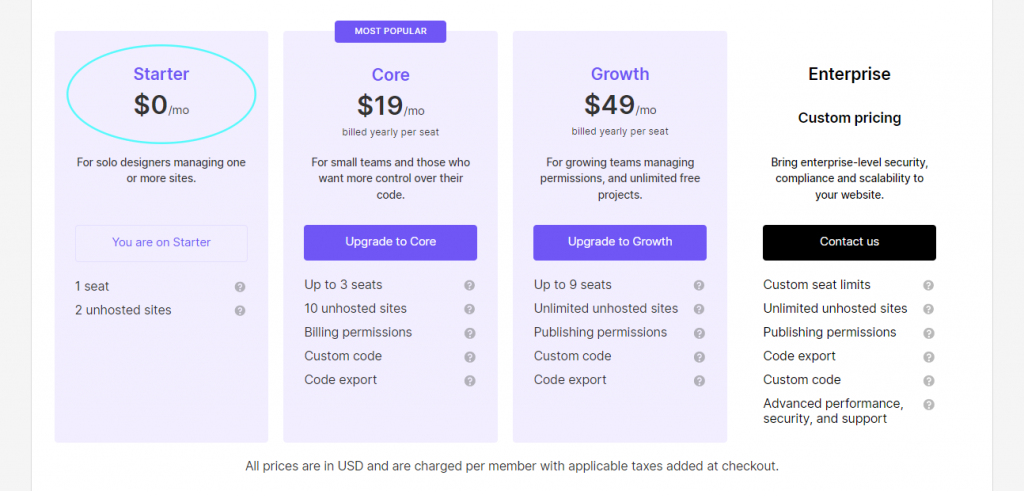
New individuals who sign up for Webflow will be utilising a free Workspace known as the Starter Workspace. In this free plan, you cannot add additional members since the “1 seat” mentioned in this plan is for you. There’s also a limit of 2 unhosted sites.
Core
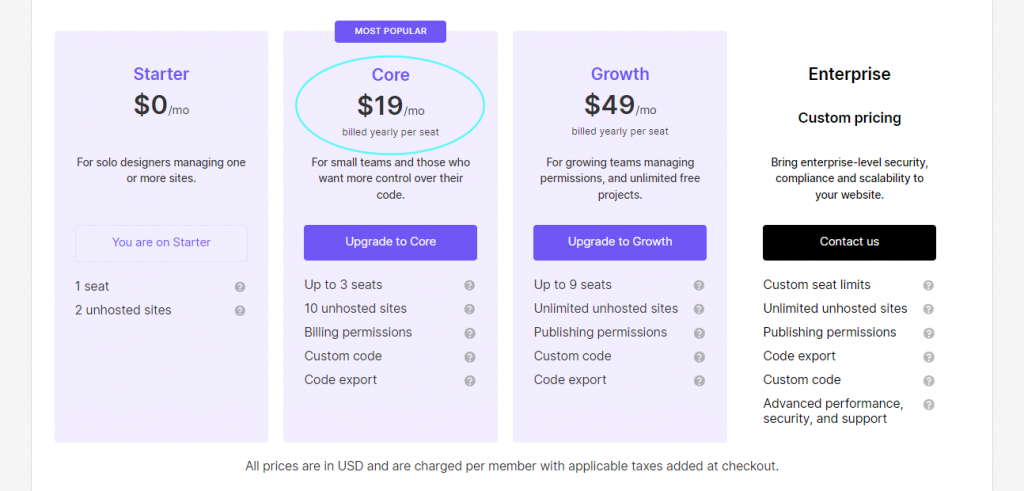
With the Core plan, you have a limit of 3 seats or members, along with 10 unhosted sites. Additionally, subscriptions and billing information may be changed by workspace administrators and owners.
Growth
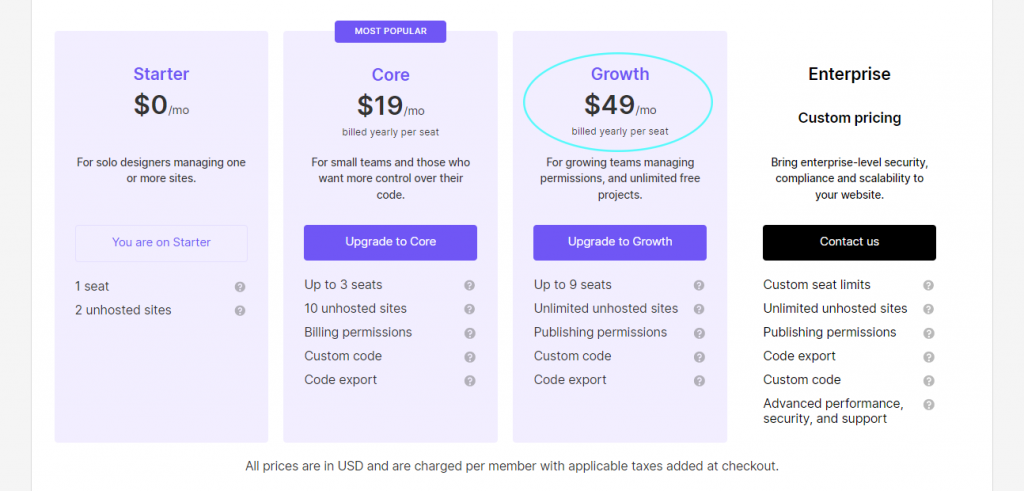
If you find that your team is expanding and will need to include more members in your Workspace, then the Growth plan might be the ideal option. You can have as many as 9 members and have an unlimited number of unhosted sites.
Enterprise
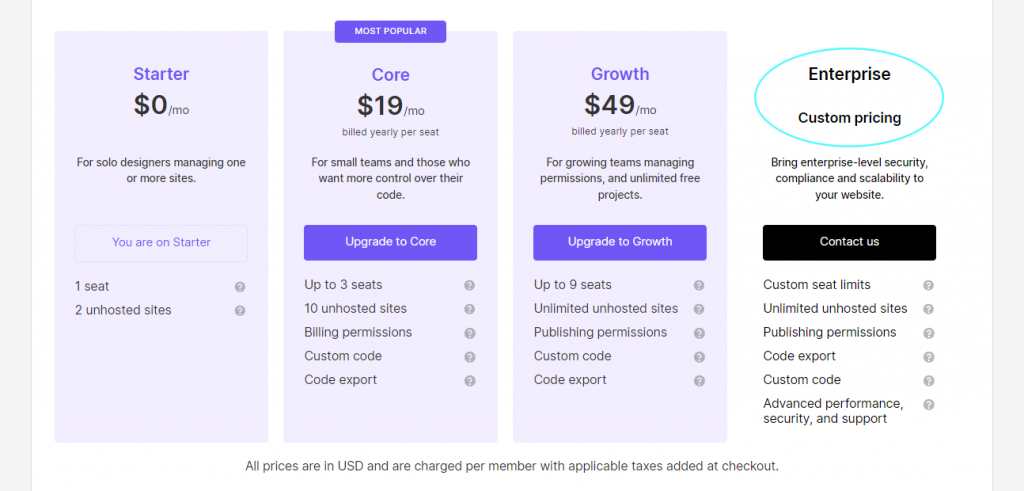
With the Enterprise plan not only will you have the same design features as the Growth plan such as having access to an unlimited number of unhosted sites, but also having more seats according to how many you need, and access to your assigned customer success manager.
Site Plans
As Webflow puts it in their Manage Site Plans lesson, “The site plan allows you to point a custom domain to your Webflow site so you can host it with Webflow and have it securely stored on Amazon Web Servers and delivered over the Fastly Network.” So when you have chosen your Workspace plan, you can choose to add your specific Site plans for your websites.
On Webflow’s pricing page, you’ll see that starting with a Core Workspace plan you can add the following Site plans for the websites you want to have a custom domain or additional specific features:
- Starter
- Basic
- CMS
- Business
- Enterprise
We’ll be going through each of the Site plans but do note that Site Plans are divided into two, Website and Ecommerce Site as shown below.
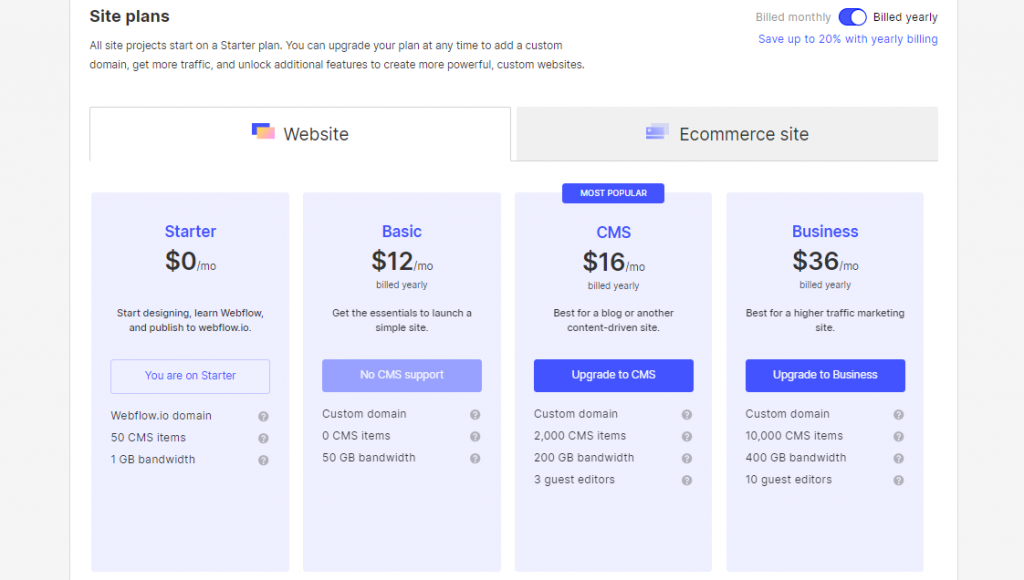
Website Plans
Starter Plan

With the starter plan, you are able to create and publish a site, without a custom domain. Your published website’s link will include .webflow.io in the end. Other than this limitation, some of the things you need to consider are: the ceiling for visits per month being 1,000, only having a total of 50 CMS elements or items as well as 2 static pages.
Basic Plan
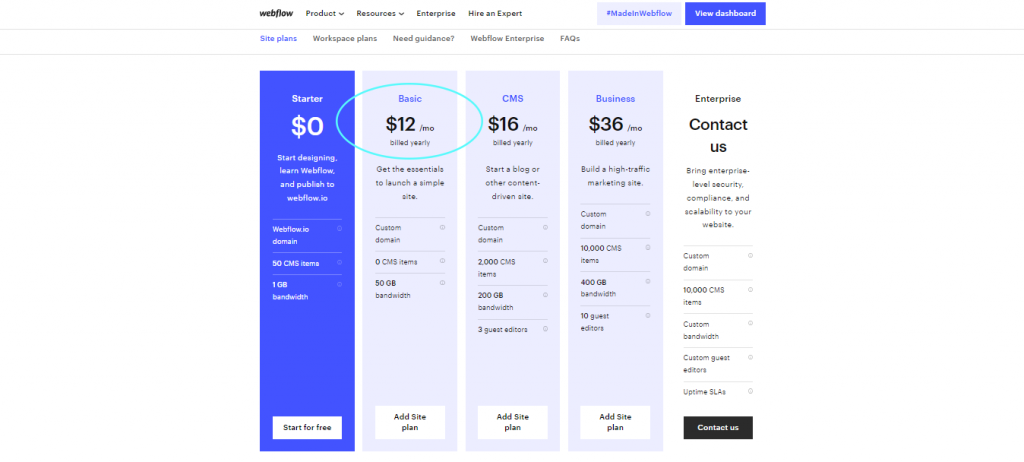
The basic plan does not really come with a number of features and functionality that you can get on the other higher site plans. However, the best thing about it is that you may use a custom domain to host your website and have access to additional pages and a 50 GB bandwidth.
CMS Plan

The CMS plan is an ideal option for those who want to have a site that has a blog section. Although, this plan comes with a limit for the number of CMS items which is 2,000, along with a maximum of 3 individuals who can edit and make content changes in the Webflow Editor.
Business Plan

With the Business plan, you’ll notice that there’s a 10,000 CMS item limit, a maximum of 10 guest editors and a 400 GB bandwidth ceiling which are all much higher compared to the CMS plan. If you read the full list of features in this plan, you’ll see that you can have a maximum of 2,500 form submissions per month as well as 250,000 monthly visits.
Enterprise Plan
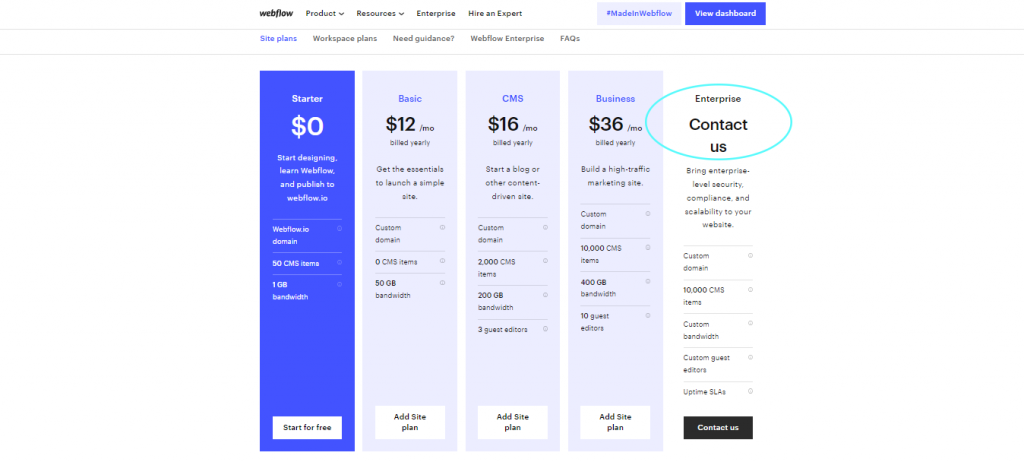
With the name itself, along with what you’ve read above regarding the Enterprise Workspace plan, the Enterprise Site plan can definitely accommodate any brand’s or business’s needs and preferences. One of the main highlights of this plan would be the Custom bandwidth and Custom guest editors, but to know if this site plan is for you, simply click the Contact us button or click this link to learn more about it.
Ecommerce Plans
Standard Plan
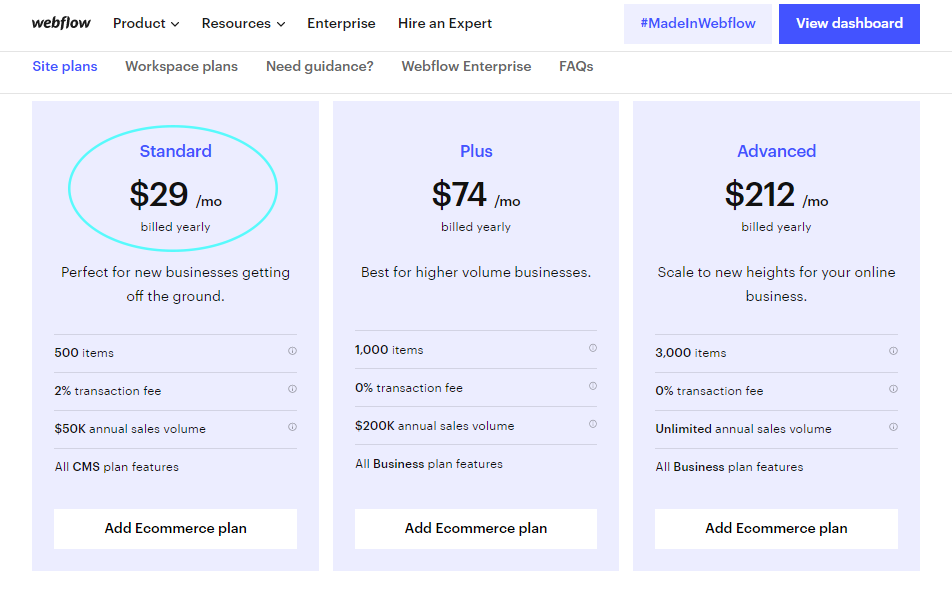
Supposing you have a small business with only a handful of items to sell, the Standard plan might be the best option for you. If you’re worried that this plan might be limited in other aspects such as tax and VAT calculation, Webflow includes automatic tax calculation at checkout. You’ll also be able to integrate Google Shopping and have a maximum of 3 staff accounts.
Plus Plan
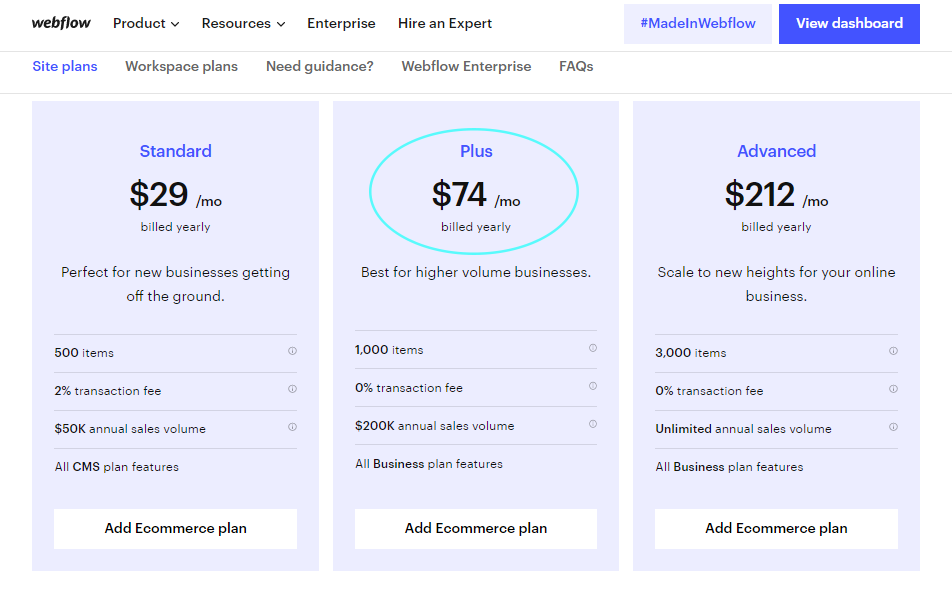
For the Plus plan, you can sell up to 1,000 items and have no transaction fee. Additionally, transaction emails can exclude any Webflow references.
Advanced Plan

If you find that both the Standard and Plus plans do not suit your business size the Advanced plan offers space for 3,000 items, 15 staff accounts, and more!
Conclusion
So, which platform is right for you? Whether you choose to build a personal Squarespace site or an online store using Webflow, you’ll always need to consider your needs.
If you want more technical customisation and flexibility, go with Webflow. However, if you’re looking for an easier platform, Squarespace is the better option.
Whichever platform you choose, be sure to take advantage of the free trial period to test out all the features and see which one you like best.
Click Here to Claim Your FREE Webflow Trial
Click Here to Claim Your FREE Squarespace Trial
Contact us today so we can help you set up your site with your chosen website builder and reach more people online. Thanks for reading!

